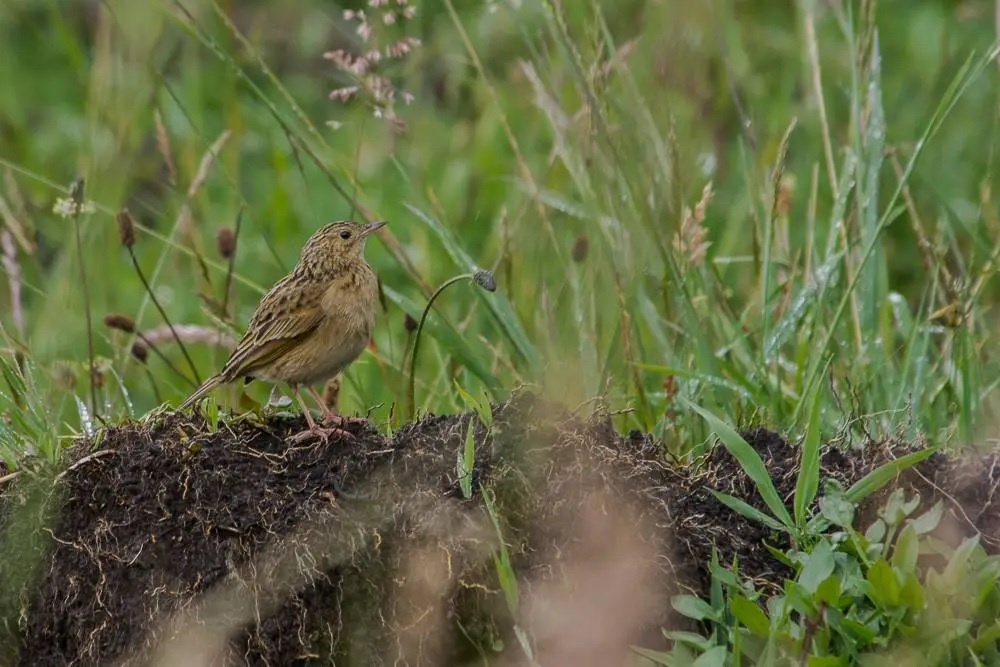The paramo pipit (Anthus bogotensis) is a species of bird in the family Motacillidae. It is found in Argentina, Bolivia, Colombia, Ecuador, Peru, and Venezuela. Its natural habitats are subtropical or tropical high-altitude grassland and pastureland.
Paramo Pipits occur through the Andes from northwest Venezuela south to northwest Argentina, and inhabit open country at elevations above 2100 m, principally arid páramo and puna grasslands, where it favors areas of level ground. Although generally considered to be resident, the probability of seasonal movements to lower elevations in the non-breeding season exists. It is usually found alone or in pairs, but occasionally in small groups of six or more, foraging on the ground in search of insects and seeds. The species is easily overlooked, despite that is reasonably common in many parts of its range. Plumage-wise, it is a relatively typical member of its genus, although the relatively less densely streaked underparts should assist the identification process to some extent.
Description
15 cm. Rather slender pipit with relatively long bill. Nominate race has faint blackish-streaked buffy supercilium, narrow whitish eyering; above , dusky to cinnamon-brown, boldly streaked blackish and buff; remiges edged buffy brown, wing-coverts dusky with buff tips (two narrow buffy wingbars); tail dusky, outer rectrix with whitish outer web and buffy inner web, adjacent feather with whitish tip; throat light buff, underparts deep buff (greyer when worn), sparse dark streaks on breast and flanks; underwing-coverts buff; iris brown; bill dusky above, pale below; legs pinkish. Sexes alike. Juvenile not described. Race meridae has broader buffy wingbars than nominate, tip of T5 buffy, not white; shiptoni almost lacks wingbars, has underparts buffy white to white, sometimes unstreaked on side, bill shorter; immaculatus is similar to previous, has crown streaks and supercilium buffy white.
Systematics History
See comments under A. hellmayri. Four subspecies recognized.
Subspecies
Paramo Pipit (meridae)Anthus bogotensis meridae
Andes in NW Venezuela (Trujillo, Mérida, N Táchira).
Paramo Pipit (bogotensis Group)Anthus bogotensis [bogotensis Group]
A. b. bogotensisA. b. shiptoniAvailable illustrations of subspecies in this group
Anthus bogotensis bogotensis
NW Venezuela (Páramo de Tamá, in S Táchira) and Andes from Colombia (N and S parts of C range, also E range S to Cundinamarca) S to N Peru (Cajamarca).
Anthus bogotensis immaculatus
NC Peru S to Bolivia (La Paz, Cochabamba).
Anthus bogotensis shiptoni
NW Argentina (Tucumán).
Distribution
It is found in the Andes of Argentina, Bolivia, Colombia, Ecuador, Peru, and Venezuela.
Habitat
Open treeless, often arid moorland and puna grassland in upper montane zone, at 2100–4200 m, locally to 4500 m. Occurs in areas having mix of short grass and bunch-grass, bogs and flats, also adjacent pastures and agricultural land; favours flatter areas.
Movement
Apparently resident; some seasonal and elevation movements may occur.
Diet and Foraging
Insects and seeds. Forages on the ground in low shrubs and grass, and in low páramo vegetation; runs through grass. Singly or in pairs, occasionally in small parties of six or more individuals.
Breeding
Probably breeds in late Mar in N of range; eggs in Dec and young birds reported in May and Sept in Peru. In nuptial flight, male rises to moderate height and makes slow gliding descent. No further data.
Conservation Status
Not globally threatened. Locally common to fairly common; uncommon to locally fairly common in Ecuador. Can be difficult to locate, and may be overlooked. Possibly occurs more widely in Colombian Andes and more continuously in S of range (Bolivia, Argentina).
Sounds and Vocal Behavior
Aerial song exuberant, musical and complex, long wheezing note followed by high chattering series, e.g. “nyeeezzzzz, dziit-it, dziit-it, chit-it-it-it-it-it” or “sweet-sweet-sweez-twee’e’e’e’e’e’e’e’e’sr’r’r’r’, tsee, tseez-tseez”; song from perch thinner, simpler, with broken phrases, e.g. “tseedle, tseedle, tslee”. Call a thin “tjirp” or “pit-sit” or “chit chit”; sometimes chattering “triee chi chi” from ground or in flight in aggressive encounters.
https://www.xeno-canto.org/259434









